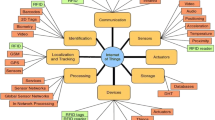Abstract
Localization in wireless sensor networks (WSNs) is a necessity as there is a vital need to have location information combined with the measured quantities. The received signal strength (RSS) based localization is a simple and a cheap model but it provides a low positioning accuracy. However, its accuracy can be enhanced by applying a cooperation mechanism among sensors. In this paper, the performance of RSS, based localization, and its cooperative version are studied, analyzed, and simulated in WSNs which operate in the millimeter wave frequency bands. Moreover, this performance is compared with that of WSNs which operate in radio bands. It can be concluded that, the positioning accuracy is high in WSNs operating in millimeter wave bands. Moreover, their performance is better than that of the corresponding WSNs operating in radio bands especially at low levels of signal to noise ratio.








Similar content being viewed by others
References
Akyildiz, I. F., Su, W., Sankarasubramaniam, Y., & Cayirci, E. (2002). Wireless sensor networks: A survey. Computer Networks,38(4), 393–422.
Yick, J., Mukherjee, B., & Ghosal, D. (2008). Wireless sensor network survey. Computer Networks,52(12), 2292–2330.
Tubaishat, M., & Madria, S. (2003). Sensor networks: An overview. IEEE Potentials,22(2), 20–23.
Arampatzis, T., Lygeros, J., & Manesis, S. (2005). A survey of applications of wireless sensors and wireless sensor networks. In International symposium on control and automation (pp. 719–724). Limassol: IEEE.
Sharma, D., Verma, S., & Sharma, K. (2013). Network topologies in wireless sensor networks: A review. International Journal of Electronics & Communication Technology,4(3), 93–97.
Dargie, W. W., & Poellabauer, C. (2010). Fundamentals of wireless sensor networks: Theory and practice, Wiley series on wireless communications and mobile computing (pp. 1–311). ISBN: 978-0-470-99765-9.
Meghani, S. K., & Asif, M. (2014). Localization of WSN node based on RTT TOA using ultra wide band & 802.15.4a channel. In 11th International conference on networking, sensing, and control (ICNSC) (pp. 380–385). Miami: IEEE.
Zheng, Y., Wang, H., Wan, L., & Zhong, X. (2009). A placement strategy for accurate TOA localization algorithm. In Seventh annual conference on communication networks and services research (CNSR) (pp. 166–170). Moncton: IEEE.
Alsindi, N., Duan, C., Zhang, J., & Tsuboi, T. (2009). NLOS channel identification and mitigation in ultra wideband TOA based wireless sensor networks. In 6th Workshop on positioning, navigation, and communication (WPNC) (pp. 59–66). Hannover.
Jeong, S., Sung, T. K., Lee, K. E., & Kang, J. (2014). Joint TOA/AOA-based localization in wireless sensor networks. In 8th International conference on signal processing and communication systems (ICSPCS) (pp. 1–5). Gold Coast.
Kaune, R. (2012). Finding sensor trajectories for TDOA based localization preliminary considerations. In Workshop on sensor data fusion (SDF) (pp. 55–59). Bonn.
Wei, J., Ji, Y., & Yu, C. (2014). Experimental verification of bias reduction in TDOA based localization. In 11th International conference on control & automation (ICCA) (pp. 7–12). Taichung: IEEE.
Zhang, R., Höflinger, F., & Reindl, L. M. (2012). TDOA based localization using interacting multiple model estimator and ultrasonic transmitter/receiver. In 9th International multi-conference on systems, signals, and devices (SSD) (pp. 1–6). Chemnitz.
Yan, Y. S., Wang, H. Y., Shen, X. H., Yang, F. Z., & Chen, Z. (2012). Efficient convex optimization method for underwater passive source localization based on RSS with WSN. In International conference on signal processing, communication, and computing (ICSPCC) (pp. 171–174). IEEE.
Chen, Y. C., Sun, W. C., & Juang, J. C. (2010). Outlier detection technique for RSS based localization problems in wireless sensor networks. In Proceedings of annual conference (SICE) (pp. 657–662). Taipei.
Muswieck, B. D. S., Russi, J. L., & Heckler, M. V. T. (2013). Hybrid method uses RSS and AOA to establish a low cost localization system. In Fourth Argentine symposium and conference on embedded systems (SASE/CASE) (pp. 1–6). Buenos Aires.
Stoyanova, T., Kerasiotis, F., Antonopoulos, C., & Papadopoulos, G. (2014). RSS based localization for wireless sensor networks in practice. In 9th International symposium on communication systems, networks & digital signal processing (CSNDSP) (pp. 134–139). Manchester.
Coluccia, A., & Ricciato, F. (2010). On ML estimation for automatic RSS based indoor localization. In International symposium on wireless pervasive computing (ISWPC) (pp. 495–502). Modena: IEEE.
AlHajri, M. I., et al. (2015). Hybrid RSS-DOA technique for enhanced WSN localization in a correlated environment. In International conference on information and communication technology research (ICTRC) (pp. 238–241). Abu Dhabi.
Tomic, S., Beko, M., & Dinis, R. (2017). 3-D target localization in wireless sensor networks using RSS and AoA measurements. IEEE Transactions on Vehicular Technology,66(4), 3197–3210.
Zhou, B., Chen, Q., & Xiao, P. (2017). The error propagation analysis of the received signal strength-based simultaneous localization and tracking in wireless sensor networks. IEEE Transactions on Information Theory,63(6), 3983–4007.
Zhu, Y., Zhang, Y., Shen, L., Yan, F., & Song, T. (2016). A cooperative localization algorithm with cluster nodes selection based on Cramer–Rao lower bound. In 84th Vehicular technology conference (VTC-Fall) (pp. 1–5). Montreal, QC: IEEE.
Liang, C., & Wen, F. (2016). Received signal strength based robust cooperative localization with dynamic path loss model. IEEE Sensors Journal,16(5), 1265–1270.
Shalaby, M., Shokair, M., & Messiha, N. W. (2017). Performance enhancement of TOA localized wireless sensor networks. Wireless Personal Communictions,95(4), 4667–4679.
Akdeniz, M. R., Liu, Y., Samimi, M. K., Sun, S., Rangan, S., Rappaport, T. S., et al. (2014). Millimeter wave channel modeling and cellular capacity evaluation. IEEE Journal on Selected Areas in Communications,32(6), 1164–1179.
Zekavat, R., & Buehrer, R. M. (2012). Handbook of position location: Theory, practice and advances. New York: IEEE Press, Wiley. ISBN 978-0-470-94342-7.
Author information
Authors and Affiliations
Corresponding author
Additional information
Publisher's Note
Springer Nature remains neutral with regard to jurisdictional claims in published maps and institutional affiliations.
Rights and permissions
About this article
Cite this article
Shalaby, M., Shokair, M. & Messiha, N.W. Performance of RSS Based Cooperative Localization in Millimeter Wave Wireless Sensor Networks. Wireless Pers Commun 109, 1955–1970 (2019). https://doi.org/10.1007/s11277-019-06662-x
Published:
Issue Date:
DOI: https://doi.org/10.1007/s11277-019-06662-x




